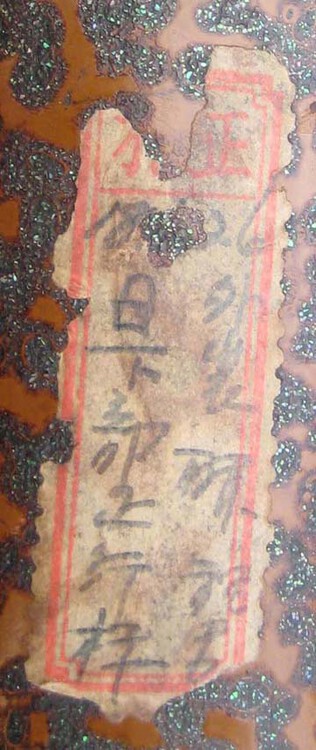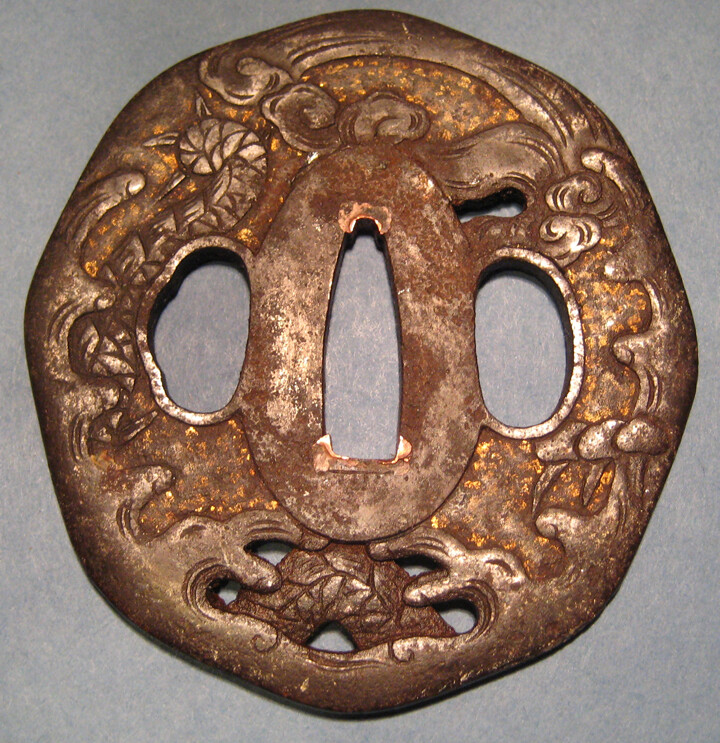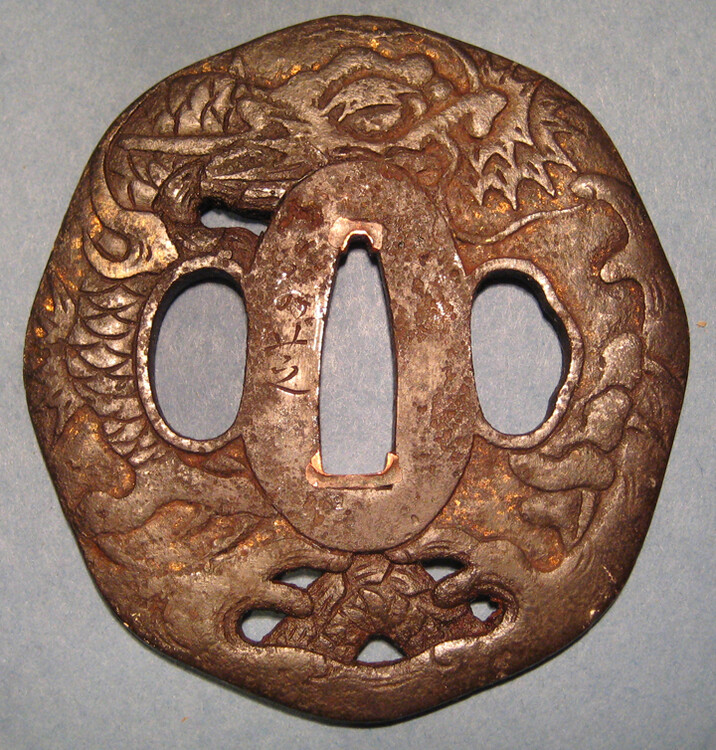-
Posts
429 -
Joined
-
Last visited
-
Days Won
1
Everything posted by Mark C
-
Thank you Jacques
-
Hi All, I've had a go at translating this mei and date and would ask for some help to see if i'm anywhere near. Mei = oite shin kuni ikutama kenryu shi sadaharu seitan kore Date = ? ? ? nen kyu gatsu ? hi Any help greatly appreciated Many thanks Mark
-
Hi, I had one very similar to this and the inset objects turned out to be small shells, unsure which type. Thats all I found out, hope that helps. All the best Mark
-
Hi, I can see Sukesada. Regards Mark
-
Thank you Koichi San. The saya had a rather scruffy looking leather cover on it and this was reveiled when it was taken off. Again, thank you All the best Mark
-
Hi everyone, Can I ask for some help on this label on a sword saya, the only bit I can translate is the numbers 18?26 This is purely curiosity to see if it has any bearing on the sword it holds Many thanks in adavnce Mark
-
Hi, If you can get to the Birmingham motorcycle museum (on the same roundabout as the NEC) on I think June 14th, there are lots of good people that you can show your sword to. I think the Northern Token Society have a table. I will check the date and let you know if it's different. All the best Mark
-

UK Shinsa 2008
Mark C replied to pcfarrar's topic in Sword Shows, Events, Community News and Legislation Issues
Mine to :D Regards Mark -
Hi All, For those who are interested (hope I haven't broke any copyright by quoting) From F & G Machine made - Produced from single bars of steel, these blades are machine-hammered and polished or plated. No grain is present and any yakiba is false, being acid-etched. The whole blade may be tempered in oil. Tai-Shu-Ko - Anti-rust steel or stainless steel blades made by the Tenshozan Company in Kamakura often have this inscribed on their tangs.Sold through the company's own retail outlet, they are associated with Showa-period Kai-gunto swords only. They are classified as machine-made. Murato - This process was invented by Tsuneyoshi Murata around the turn of the twentieth century. The blade is basically a one-piece machine-made pattern. A yakiba was produced by tempering in oil but failed to produce any nie or nioi along the hamon. Some handwork was involved in tempering and polishing, resulting in a product classifiable as superior machine-made. Mantetsu - These blades were forged by inserting a soft steel inner core into a pipe of Manchurian-made or western steel (often scrap railway lines). The characters are inscribed on the tang of Showa-period blades probably manufactured at the Mukden arsenal, Manchuria, and souh Manchurian arsenal (second Mukden arsenal constructed in 1939 and under the direct control of the Japanese Army from Tokyo). Manchurian blades are classifiable as superior machine-made. Gendaito - These hand-forged blades have been made in the traditional manner since 1868. The best of modern sword blades, but purists nonetheless consider them inferior to Koto and Shinto examples because the yakiba is said to be weaker in comparison. Nioi and nie are produced by water tempering. A hada is also present. Showato - All blades produced since 1926 should be properly termed Showato. Though often used for machine-made blades, it must encompass all types - including Showa period gendaito. Regards Mark C
-

UK Shinsa 2008
Mark C replied to pcfarrar's topic in Sword Shows, Events, Community News and Legislation Issues
Hi Shan, Nothing specific apart from my own as mentioned above, I just see a few pink slips coming out of envelopes whilst I was waiting around socialising and drinking large amounts of coffee as my slots were early and late on the saturday. Hope the news is good, when you receive it. Regards Mark -

UK Shinsa 2008
Mark C replied to pcfarrar's topic in Sword Shows, Events, Community News and Legislation Issues
Hi Peter, Not as suprised as I was Meaning the Izumi kami and the Minamoto masakuni. Some others unfourtunately had shocks of a different kind I hope you are all having an enjoyable day. regards Mark -

UK Shinsa 2008
Mark C replied to pcfarrar's topic in Sword Shows, Events, Community News and Legislation Issues
Hi All, Results are in. Minamoto Masakuni, Shinteisho (60 points), Kaei (1850). This one myself and Paul B thought was earlier, Ah well you live and learn. Mumei Wak,Kanteisho (70 points), Atribution of den Kashu Ietsugu, Tenbun 1540. Mumei Wak, Kanteisho (73 points), Atribution of den Noshu Jumyo, Kanbun 1650. Tanto signed Izumi no Kami and Hachi gasti hi, Pinked but Estimated Uda School, Etchu province, 1570's Met lots of friendly people and had an excellent but long day. Regards Mark C -
Excellent sword. fantastic photography. Certainly a dream sword for me, maybe the Euro lottery will come in tonight :D Mark c
-

UK Shinsa 2008
Mark C replied to pcfarrar's topic in Sword Shows, Events, Community News and Legislation Issues
I'll be there on the Saturday. Submitting 4 swords also, 1 mumei Katana, 1 mumei & 1 signed wakizashi and 1 signed tanto. Hopefuly see you there. Regards Mark -
Hi all, I need some help with this tsuba please. I think it's signed Jakushi and there seems to be a lot of gold under the dirt etc. I did a search on the board and found a post back in Nov 2007 that says that a dragon theme and lots of gold are not uncommon for Jakushi Nidai. Could this be Any help will NOT be used for commercial purposes and will be greatly appreciated. Thanks Mark
-
Hi All, Lots of good answers, thanks. It was just a kind offer from my friend that after reading the above I will decline. The box or label on the Shirasayabukuro are the best way to go I think. Many thanks. Regards Mark
-
Hi Grey, Thanks for that. I was going to get her to copy from the papers the smith, era and length. I don't intend to sell but who knows what might happen in the future so your advice is sound advice and I will leave well alone. Many thanks Mark
-
Hi All, Having various swords with papers in shirasaya and a Japanese friend who has said that she will do the sayagaki for me, I have one question: What ink is used for sayagaki? Many thanks for your help Regards Mark
-
Hi All, I cant thank you all enough and as a mere beginner, this Tanto has had me pulling what little hair I have, out with the hada, hamon contradicting nakago condition. I was going to put the other photo's I have but Paul beat me to it, and I have to give him the credit for taking them in the first place. I will hit the books again tonight as I have a little more info, It's only 5 weeks to wait and I will post results, if people are interested. Again, thanks Regards Mark
-
Thanks Nick, I wonder if the NTHK would clasify it as ato mei (if indeed they thought it to be a Masakuni ) or pink it ?? Regards Mark
-
Hi Jacques and Paul, Thanks for the help. Paul - Like you, I find this little blade most interesting, ito suguha hamon, itame nagare hada. When you say you think the mei was added later, does this make it gimei ?? I think I will put this in for the November UK Shinsa. Again, many thanks Regards Mark
-
Hi Jacques and all, Sorry, I did mean to attach a pic, anyways here's the pic of the nakago. Regards Mark
-
Hi All, I have a tanto that has a mei of "minamoto masakuni tsukuru kore". I have been searching my limited library and the www for a comparison mei but haven't managed to find one Can I please ask if anyone has a picture/info, could they please post or PM it. Many thanks in advance. Mark
-
Hi Rick, I think this is one method of resizing the hitsu-ana, I like to see pieces of copper rather than these sort of marks regards mark
-
Hi Ford, Many thanks for your reply. So, late Mito work, I'm happy with my little find I have attached a close-up pic of the mei area and you are right about the left of the ana but the right hand side seems a little better. Again thanks regards Mark









